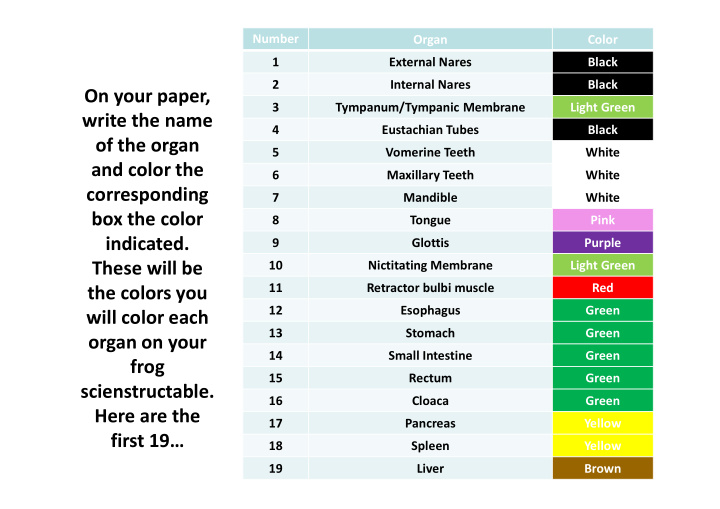



Number Organ Color 1 External Nares Black 2 Internal Nares Black On your paper, 3 Tympanum/Tympanic Membrane Light Green write the name 4 Eustachian Tubes Black of the organ 5 Vomerine Teeth White and color the 6 Maxillary Teeth White corresponding 7 Mandible White box the color 8 Tongue Pink indicated. 9 Glottis Purple These will be 10 Nictitating Membrane Light Green 11 Retractor bulbi muscle Red the colors you 12 Esophagus Green will color each 13 Stomach Green organ on your 14 Small Intestine Green frog 15 Rectum Green scienstructable. 16 Cloaca Green Here are the 17 Pancreas Yellow first 19… 18 Spleen Yellow 19 Liver Brown
Number Organ Color 20 Gall Bladder Green 21 Kidneys Brown 22 Bladder Yellow 23 Lungs Purple 24 Heart (24L, 24R, and 24V) Red Here are the 25 Common Femoral Artery Red remaining 19 26 Common Femoral Vein Blue organs. Be 27 Sartorius Red sure to color 28 Gracilis major Red the box with 29 Teste (male) Yellow the appropriate 30 Ovary (female) Yellow 31 Eggs (female) Black & White color! 32 Fat Bodies Orange 33 Nuptial Pad (males only) Light Green 34 Spine White 35 Brain Gray 36 Rectus abdominus Red 37 Pectoralis Red 38 Obliquus externus Red
Frog Dissection: Comparing Anatomy - Vertebrates Creating the Frog Scienstructable What You Do: Once you have completed your key, begin the reading to determine what all of these organs do – many of them have the same function as human beings! Remember to use good reading as you read. On your paper, write the function of each organ in the appropriate column. For example: Number Organ Color Function External nostrils used for breathing when 1 External Nares Black mouth is closed 2 Internal Nares Black … dirty gerdy smelly mellie gnllc
Number Organ Function 1 External Nares External nostrils used for breathing when mouth is closed 2 Internal Nares Internal nostrils used for breathing when mouth is closed 3 Tympanic Membrane External eardrum used to sense vibrations for hearing 4 Eustachian Tubes Opening to tympanum, equalizes pressure in inner ear 5 Vomerine Teeth Cone teeth used to grasp prey 6 Maxillary Teeth Cone teeth located on upper jaw, helps to grasp prey 7 Mandible Lower jaw, helps to grasp prey 8 Tongue Muscle used to grasp food 9 Glottis Slit in base of mouth leading to the trachea 3 rd eyelid - covers eye for protection during swimming & eating 10 Nictitating Membrane 11 Retractor bulbi muscle Used to help push food into esophagus 12 Esophagus Tube that carries food from mouth to stomach 13 Stomach Breaks down and stores food 14 Small Intestine Responsible for most chemical digestion 15 Rectum Stores solid waste until excreted from body 16 Cloaca Common exit for feces, urine, sperm and egg 17 Pancreas Makes insulin to aid in digestion 18 Spleen Stores and filters red blood cells 19 Liver Makes bile to aid in the digestion of fat
Number Organ Function 20 Gall Bladder Stores bile made by the liver 21 Kidneys Filters blood of waste 22 Bladder Stores urine 23 Lungs Works in the exchange of oxygen and carbon dioxide 24 Heart Left and Right atria (receive blood) & Ventricle (pumps blood) 25 Common Femoral Artery Carries oxygenated blood from heart to lower part of leg 26 Common Femoral Vein Carries deoxygenated blood from lower part of leg to heart 27 Sartorius Used in jumping and movement 28 Gracilis major Used in jumping and movement 29 Teste (male) Responsible for making sperm 30 Ovary (female) Responsible for making eggs 31 Eggs (female) Reproductive cell 32 Fat Bodies Food reserve for hibernation/mating 33 Nuptial Pad (males only) Used for grasping female during amplexus 34 Spine Vertebrae support frog skeletal system, protect spinal cord 35 Brain Responsible for controlling frog’s activities and body functions 36 Rectus abdominus Muscles that aid in movement 37 Pectoralis Muscles that aid in movement 38 Obliquus externus Muscles that aid in movement
Recommend
More recommend